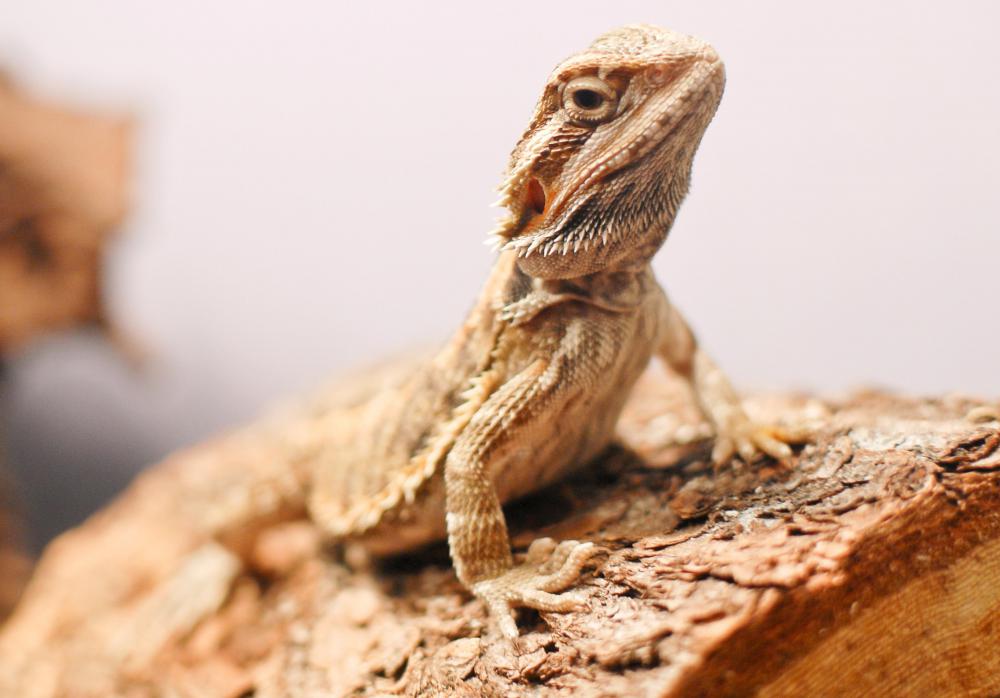At AllThingsNature, we're committed to delivering accurate, trustworthy information. Our expert-authored content is rigorously fact-checked and sourced from credible authorities. Discover how we uphold the highest standards in providing you with reliable knowledge.
What Is Typical Bearded Dragon Behavior?
Bearded dragons are a joy to keep as pets, and understanding their behavior makes it easy for a pet owner to interpret their states of mind. While beardies display some behaviors in the presence of owners, certain behaviors are reserved only for the company of other bearded dragons. They display a range of territorial, social, and health-related behaviors, with some indicating intense emotion. Bearded dragon behavior can be easily understood by interpreting visual cues, such as an inflated beard, head bobbing, and arm waving. Circling, hissing, and piling up are some other behaviors that beardies engage in.
The inflated beard, or bearding, is a widely recognized bearded dragon behavior. The beardie expands the bony appendage under its neck, which makes it look like it has a beard. While this is seen in both sexes, males display it more often to assert their authority over younger beardies and females. The beards may turn black when displayed in this way, and the color may spread down to the shoulder in the case of males. While males show off by blowing out their beards for the females during breeding season, females usually puff up their beards as a sign of aggression.

In addition to puffing out the beard, the beardie may additionally start bobbing its head. Sometimes, they will bob when the owner approaches the cage as though they are saying hello. In the presence of a female dragon, though, a fast, intense type of bob indicates the dragon's readiness to mate. The speed and intensity of the head bob indicates the dragon's emotions, and it typically involves a show of power or desire. A slow head bob, which resembles a nod, could be a sign of submission, while a faster bob indicates aggression.

Another very common bearded dragon behavior that many pet owners find amusing is their tendency to wave their arms. The beardie lifts its front leg and waves it in a circular motion. They balance themselves on their other three legs and may also swap legs at times. Female and younger dragons display this behavior when males enter their territory as a sign of submission. In the case of females, it may also signal a willingness to mate or a desire to keep away from aggressive males.
Hissing may be a startling bearded dragon behavior for pet owners, but it is simply a defense signal. Beardies may also circle and chase each other, and this behavior is seen during breeding or fighting. Dragons who circle each other with their mouths open are spoiling for a fight and will bite if the opportunity presents itself.
Sometimes, beardies will pile up on each other, and while this behavior looks affectionate, it is anything but. The dragon on top is asserting its dominance by covering the other. Another typical bearded dragon behavior is the tail-up position, which is seen when the beardie is in a hunting mood.
Frequently Asked Questions
What are common signs of a healthy bearded dragon?
A healthy bearded dragon will exhibit behaviors such as active exploration of their environment, regular eating and digestion, and alertness to their surroundings. They should have clear, bright eyes and a body free of sores or abrasions. Healthy dragons also engage in thermoregulation, basking under heat lamps, and seeking cooler areas as needed.
How do bearded dragons show they are stressed or unwell?
Bearded dragons may show stress or illness through behaviors like hiding more often, decreased appetite, lethargy, or irregular bowel movements. Physical signs can include sunken eyes, discolored skin, or a swollen abdomen. If you notice these symptoms, it's important to consult a veterinarian experienced with reptiles.
Do bearded dragons enjoy being handled, and how can you tell?
Many bearded dragons tolerate or even enjoy handling if done gently and respectfully. Signs of enjoyment include a relaxed posture, no attempts to escape, and no signs of aggression like hissing or puffing up their beard. Always approach your dragon calmly and support their entire body when handling them.
What does it mean when a bearded dragon waves or bobs its head?
Head bobbing in bearded dragons can signify dominance or territorial behavior, often seen in males. Conversely, arm waving is a submissive gesture, indicating acknowledgment of another dragon's dominance or sometimes as a sign of recognition to their human caretakers. These behaviors are part of their natural communication repertoire.
How can you tell if a bearded dragon is getting enough to eat?
A well-fed bearded dragon will have a rounded, not bloated, belly and show steady growth according to their age and species norms. Juveniles should eat more protein and grow rapidly, while adults eat more plant matter and grow more slowly. Monitoring weight and consulting growth charts can help ensure they're on track.
What kind of social interaction do bearded dragons require?
Bearded dragons are generally solitary creatures and do not require social interaction with other dragons to thrive. In fact, housing them together can lead to stress and aggression. Interaction with their human caretakers, such as handling and feeding, can be sufficient for their social needs when done consistently and gently.
AS FEATURED ON:
AS FEATURED ON:












Discussion Comments
Well, if you have spent some time with it and socialized with it, it will most likely come up to the glass on your aquarium/terrarium to greet you when you walk into the room.
Normally, they will sit in the spot that you have as your heat spot to bask in the heat. If your dragon isn't eating, put some applesauce in a little bit of some veggies and put it on their lips and they will be forced to eat.
Post your comments